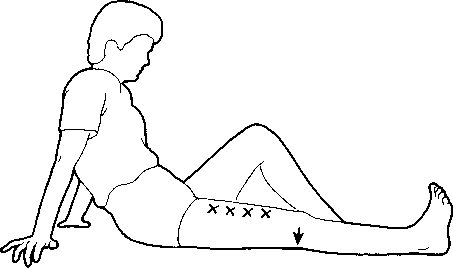- You are here:
- Home »
- Blog »
- Joint Health / Pain »
- The Ultimate Guide to the Most Misunderstood Exercise for Knee Pain
The Ultimate Guide to the Most Misunderstood Exercise for Knee Pain
If you’ve had knee pain and seen a physical therapist, orthopedist, or personal trainer for help, there’s a good chance that you’ve been issued this exercise – the “Quad Set”.
And as ubiquitous as a Quad Set is for knee pain, it’s also the most misunderstood exercise for knee pain.
The Quad Set is an isometric exercise of the four muscles of the thigh – the quadriceps muscles: “Quad” for quadriceps and “Set” for “setting” or contracting the muscles.
One of the reasons that the Quad Set is recommended as a solution for knee pain is for a presumed or observed mal-tracking patella or, in other words, your kneecap doesn’t travel in a straight line.
When the quadriceps contracts and pulls on the patella (knee cap), most people assume that the knee cap should travel up the leg in a straight line so if it looks like it doesn’t, that must be why your knee hurts.
The thinking is that one of the quadriceps muscles – the Vastus Medialis Oblique – the one on the inside of the thigh – is weak which then allows your patella (kneecap) to drift or move the wrong way when the muscle tightens.
The incorrect patella motion then causes pain from an increase in pressure between the kneecap and thigh bone.
However, the patella doesn’t move in a straight line when you tighten the thigh muscles normally and, in fact, people who have a mal-tracking patella don’t have any more knee pain than people who don’t.
In one study, 50 people who had kneecap pain were compared with 47 people who had never had kneecap pain. The painful group had better kneecap position and motion than the non-painful group as revealed by MRI.[1]O’Donnell P, Johnstone C, Watson M, McNally E, Ostlere S. Evaluation of patellar tracking in symptomatic and asymptomatic individuals by magnetic resonance imaging. Skeletal Radiol. 2005 … Continue reading
And, even if this were true, the idea that you can isolate one of the quadriceps muscles and selectively strengthen it, is a myth.
But, strengthening your leg muscles is a good thing to do and, while the Quad Set can get you started down that path, it has an even greater benefit to your knee.
Can a Quad Set Strengthen the Thigh Muscles?
The quad set is an isometric exercise.
An isometric exercise is one in which no movement of a joint occurs. Isometric comes from the Greek words ISOS – same – and METRIA – measuring.
In addition to isometric exercise, muscles can be strengthened by concentric (a shortening of the muscle), eccentric (the muscle lengthens while also contracting) and something I call a variable isometric where the tension in the muscle varies from low to high by the movement of the body while the targeted joint doesn’t move.
With an isometric exercise, the exercised muscle remains the same length. So, in the case of the knee, the knee joint, where the femur (thigh bone) connects to the tibia (shin bone), remains fixed, usually straight.
You can perform the exercise in a variety of positions – lying down, sitting, standing – but most often it’s done in “long sitting” (as pictured).

Common position for the Quad Set exercise
In this position, you tighten the muscle as much as you can and hold the contraction for 5 to 10 seconds. This is considered one repetition.
The dosage – the number of repetitions (grouped as sets) and the number of sets per day and week – to strengthen muscle varies from as few as 5 to as many as 25 or 30 repetitions per set with 24 to 48 hours in between exercises sessions. The number of sets per week is typically three.
The common dosage for quad sets is between 10-15 repetitions – one set – for three sets per day.
This is something important to point out. All strength exercises require rest of at least one day if not more. Yet, the Quad Set is almost always prescribed to be done daily.
Is there something special about this exercise that somehow enables your muscles to not require the same rest as in, say, a squat?
No. The reason you can do a Quad Set every day is that the level of fatigue created by the exercise is mild. Maybe, in some cases, when you first start the exercise, you might have more than mild fatigue but it doesn’t take long for your brain to learn how to do the exercise at which point you have to make it harder to do. And even then, its’ strengthening effect is minimal.
The key to strengthening muscle is producing sufficient fatigue within the designated number of sets.
The fundamental requirement for muscle strengthening is progressive overload – a consistent increase in demand that the muscle(s) must meet. The demand can be either an increase in load (weight lifted or moved), the number of repetitions performed, the range of movement, reducing the rest between sets, or increasing the speed of the movement.
With Quad Sets, no movement occurs so this leaves only the number of repetitions as the stimulus for strengthening.
If your quadriceps muscles are weak enough, quad sets can improve their strength but eventually, you will have to choose a different exercise to increase the strength enough to make a difference in your functional ability [2]https://www.sciencedirect.com/science/article/abs/pii/S1360859217301377
Why Are The Quadriceps Weak?
One of the main reasons your quadriceps can be weak is the presence of fluid in your knee joint. You might argue that because your knee doesn’t look swollen that it’s not but even a small amount of extra fluid in the joint, small enough you can’t see it, will inhibit or reduce the muscle’s ability to contract [3]Spencer, J. D., et al. (1984). “Knee joint effusion and quadriceps reflex inhibition in man.” Arch Phys Med Rehabil 65(4): 171-177.] [Rice, D. A., & McNair, P. J. (2009). Quadriceps … Continue reading
You can try all you want to strengthen your muscles but until the swelling decreases, quad sets will fail to deliver on strengthening the muscles.
Quad Sets Aren’t Great for Strength but They Are Great For Something Else
We routinely use quad sets with our clients who have knee pain but for a different reason than muscle strengthening.
The fluid inside your joint – synovial fluid – serves a couple of purposes. It helps reduce friction in the knee joint making movement easier, smoother and it adds extra cushioning to help reduce the forces traveling up your leg. [4]Tamer, T. M. (2013). Hyaluronan and synovial joint: function, distribution and healing. Interdiscip Toxicol, 6(3), 111-125.
A common problem seen in people with knee arthritis is that the synovial fluid becomes thin, watery and, as a result, the knee doesn’t function as well it should.
Quad sets can change this.
The synovial fluid viscosity increases after quad sets. This helps reduce friction in the joint and reduce pain.
However, the dosage for this, at least 90 repetitions per day, is much higher than that for strengthening muscle and it takes about two months for the effects to appear.[5]Miyaguchi, M., Kobayashi, A., Kadoya, Y., Ohashi, H., Yamano, Y., & Takaoka, K. (2003). Biochemical change in joint fluid after isometric quadriceps exercise for patients with osteoarthritis of … Continue reading
I advise clients to aim for 100 repetitions per day with 10 repetitions per set. You don’t have to perform all 100 repetitions in one session. You can space them out over the day.
How to Perform a Quad Set Optimally
While a quad set seems like a simple enough exercise to do, there are a few details that can make a big difference in the effectiveness.
The most common instruction is to push the back of the knee down into the table or floor but sometimes doing this while tightening the muscles as much as possible can create knee pain most often around or under the knee cap.
There are a couple of tweaks to try.
The first one is to think of pulling the kneecap upward toward the thigh like you’re sliding the kneecap up the leg. In fact, in one study, this was shown to work better than the standard method.[6]https://www.ncbi.nlm.nih.gov/pmc/articles/PMC4211772/
The second thing to try is to place a small towel roll under your knee. As you press the knee down into the towel, tighten your hamstring muscles at the same time as you tighten the quadriceps. This reduces the travel of the joint and tends to also reduce focal pressure under the knee cap.
A third option is to lie face down with your toes of the involved leg contacting the floor or table. Your knee will naturally be flexed a few degrees from the positioning of the toes.
Now tighten the quadriceps which will cause the knee to straighten.
Finally, a fourth option is to add tightening of all the leg muscles including the opposite leg. We call this a “sizzler”. The technical term is hyperirradiation. By tightening the other muscles, you increase the neural output to the quadriceps muscle (my colleague Laurie Kertz Kelly explains in her video a few of her tips on performing a quad set).
You can tighten your quadriceps while standing in line at the grocery store, sitting in traffic, on a plane or train. Just about anywhere. And since the goal is not primarily muscle strengthening, the more reps you do, the better.
The Quad Set can help your knee pain a lot but it’s something that takes time to do and time to reveal the benefits.
In that way, it’s a lot like a weight loss plan.
You can’t expect to execute the strategy for weight loss for a couple of weeks and reach your goal.
You have to keep at it, day after day, week after week, and eventually, all of that effort translates into something tangible.
Same thing with Quad Sets for knee pain. Do it every day, day after day and in about two months, you’ll likely notice that your knee feels better.
Thanks for reading.

If you like this article, why not share it with a friend? If you’re interested in coaching services, please contact my colleague Laurie Kertz Kelly for a free, 20-minute Strategy Session by, clicking here. To get my Secret Weapon to fight knee, hip & back pain and stiffness, subscribe for free today.

Doug Kelsey has been a physical therapist and human movement expert since 1981. He is formerly Associate Professor and Assistant Dean for Clinical Affairs at the University of Oklahoma Health Sciences Center and the author of several books. He has conducted over 250 educational seminars for therapists, trainers, physicians, and the public and has presented lectures at national and international scientific and professional conferences. His professional CV is here.
References
| ↑1 | O’Donnell P, Johnstone C, Watson M, McNally E, Ostlere S. Evaluation of patellar tracking in symptomatic and asymptomatic individuals by magnetic resonance imaging. Skeletal Radiol. 2005 Mar;34(3):130-5. |
|---|---|
| ↑2 | https://www.sciencedirect.com/science/article/abs/pii/S1360859217301377 |
| ↑3 | Spencer, J. D., et al. (1984). “Knee joint effusion and quadriceps reflex inhibition in man.” Arch Phys Med Rehabil 65(4): 171-177.] [Rice, D. A., & McNair, P. J. (2009). Quadriceps Arthrogenic Muscle Inhibition: Neural Mechanisms and Treatment Perspectives. Semin Arthritis Rheum. |
| ↑4 | Tamer, T. M. (2013). Hyaluronan and synovial joint: function, distribution and healing. Interdiscip Toxicol, 6(3), 111-125. |
| ↑5 | Miyaguchi, M., Kobayashi, A., Kadoya, Y., Ohashi, H., Yamano, Y., & Takaoka, K. (2003). Biochemical change in joint fluid after isometric quadriceps exercise for patients with osteoarthritis of the knee. Osteoarthritis Cartilage, 11(4), 252-259. doi:10.1016/s1063-4584(02)00372-2 |
| ↑6 | https://www.ncbi.nlm.nih.gov/pmc/articles/PMC4211772/ |
